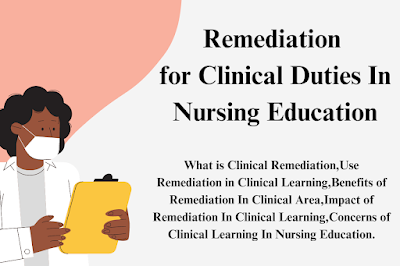Clinical Duties In Nursing Education What is Clinical Remediation?
Clinical remediation is the process of correcting deficiencies in nursing practice and promoting safe patient care through the use of tailored learning strategies to improve critical thinking and clinical performance (Evans & Harder, 2013; Merriam-Webster Dictionary Online). Clinical remediation is often necessitated by various deficiencies identified in academic, clinical, or regulatory contexts. These deficiencies can be revealed through examinations, direct observation, peer reviews, or failures to meet established standards of care (Evans & Harder, 2013; Walker Cillo & Harding, 2013).
Use of Remediation in Clinical Learning
The application of clinical remediation is broad and multifaceted in nursing education. It serves as a mechanism for continuous learning beyond formal education, emphasizing lifelong professional development for nurses in all fields of practice. Clinical remediation plans are utilized in both academic and clinical practice settings and are also integral to regulatory policies aimed at maintaining minimum standards of practice.
Clinical remediation begins with identifying deficiencies that could compromise safe practice. It is a structured process that emphasizes objectivity, openness, and transparency, while respecting the right to due process for those undergoing remediation. The process is student-centered, adapting to individual learning needs and addressing specific deficiencies. Remediation plans should be personalized and supported by various strategies, such as tutoring, advising, counseling, and skill-building activities. Effective strategies for remediation include simulation exercises, case presentations, and the integration of theoretical and scholarly resources (Evans & Harder, 2013; Gallant, MacDonald, & Smith Higuchi, 2006; Walker Cillo & Harding, 2013).
Benefits of Remediation in the Clinical Area
Remediation plays a crucial role in assisting struggling students to achieve the minimum standards for practice and successfully complete their academic programs. Nurse educators can identify students who perform poorly during clinical encounters, whether real or simulated, and develop structured plans to address their needs.
These plans create a positive and supportive learning environment with clear learning objectives, multiple sources of evidence, and timely feedback (Evans & Harder, 2013; Gallant et al., 2006). Remediation enables students to gain confidence and competence by addressing their weaknesses and reinforcing their strengths. It also helps ensure that all nursing graduates are adequately prepared to provide safe and effective patient care.
Impact of Remediation in Clinical Learning
The impact of remediation in clinical learning is significant, as it provides various methods to address individual learning needs. These methods include:
- Close Observation: Allows educators to directly monitor students’ actions and provide immediate feedback.
- Repetition: Reinforces learning by allowing students to practice specific skills or tasks multiple times.
- Self-Directed Learning: Encourages students to take responsibility for their own learning by identifying areas of weakness and seeking out resources to address them.
- Structured Classes and Scenarios: Offer opportunities to practice critical thinking and decision-making in controlled settings.
- Case Studies: Provide students with realistic clinical situations to analyze and solve.
Other tools used in remediation include mechanical simulators and standardized patients, which help recreate clinical scenarios for practice. These tools allow for repetitive learning with immediate feedback and debriefing, which is essential for identifying both weaknesses and strengths (Audétat, Laurin, & Dory, 2013; Evans & Harder, 2013; Klamen & Williams, 2011; Lynn & Twigg, 2011).
Mechanical Simulators: Provide a controlled environment where students can practice various clinical skills and procedures. These simulators allow for a safe learning environment where mistakes can be made and corrected without harming actual patients.
Standardized Patients: Are trained actors who simulate real patient encounters, allowing students to practice communication, assessment, and other clinical skills in a realistic context. This approach helps bridge the gap between theoretical knowledge and practical application.
While these methods have proven effective, several challenges can affect the remediation process. These challenges include the lack of theoretical and conceptual frameworks in developing interventions, delays in implementing remediation, and stress and anxiety experienced by students undergoing remediation. These challenges can be mitigated through well-developed plans, early identification of problems, and mutual respect between educators and students (Audétat et al., 2013; Evans & Harder, 2013).
Concerns of Clinical Learning in Nursing Education
Clinical remediation remains a vital component of nursing education. However, there are concerns related to the cost and resources required for effective remediation. Technological advancements, computerization, and simulation will continue to be important elements in the remediation process. Integrating case scenarios with mechanical simulation and the use of standardized patients can enhance students’ preparedness for real-world clinical encounters and patient care.
The financial viability of nursing programs may be impacted by the cost of faculty, technology, and resources needed for remediation. However, the sharing of resources among various schools can help mitigate these costs. Collaborative use of simulation labs, faculty, and computer resources can optimize the financial sustainability of clinical remediation programs.
Additionally, collaboration among healthcare professionals is crucial to ensure safe patient care. The ultimate goals of clinical remediation are to promote patient safety, uphold standards of care, and support the professional development of nursing students.
Conclusion
Clinical remediation is a critical strategy in nursing education, designed to correct deficiencies and promote safe, effective nursing practice. It provides a structured approach for identifying and addressing gaps in knowledge, skills, and competencies, ensuring that nursing students are prepared to deliver high-quality patient care. By utilizing various remediation methods, including simulation, case studies, and standardized patients, nursing educators can create a positive learning environment that supports continuous improvement and professional growth.
To maximize the benefits of clinical remediation, it is essential to develop individualized plans that address specific learning needs, provide timely feedback, and foster mutual respect between educators and students. Additionally, addressing concerns related to cost and resource allocation will help ensure the sustainability and effectiveness of remediation programs in nursing education. As the healthcare environment continues to evolve, clinical remediation will remain a cornerstone of nursing education, helping to prepare competent and confident nursing professionals who are equipped to meet the challenges of modern healthcare.
